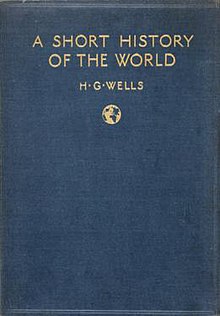 1st edition (1922), Cassell & Company | |
| Author | H. G. Wells |
|---|---|
| Subject | General history |
| Publisher | Cassell & Company (London), The Macmillan Company (New York) |
Publication date | 1922 |
| Pages | 432 (Cassell), 455 (Macmillan) |
| OCLC | 3499379 |
| Text | A Short History of the World at Wikisource |
A Short History of the World is an account of human history by English author H. G. Wells. It was first published in 1922 by Cassell & Company (London) and The Macmillan Company (New York).[1] The book was preceded by Wells's fuller 1919 work The Outline of History, and was intended "to meet the needs of the busy general reader, too driven to study the maps and time charts of that Outline in detail, who wishes to refresh and repair his faded or fragmentary conceptions of the great adventure of mankind."[2]
The first edition had around 400 pages, with about 200 illustrations, including 21 maps.[3] Later editions were published with updated accounts of world events.[4] It was published in Penguin Books in 1936, and republished under Penguin Classics in 2006.[citation needed]
The book summarises the scientific knowledge of the time regarding the history of Earth and life. It starts with its origins, goes on to explain the development of the Earth and life on Earth,[5] reaching primitive thought and the development of humankind from the Cradle of Civilisation.[6] The book ends with the outcome of the First World War, the Russian famine of 1921, and the League of Nations in 1922.[7][8]
In 1934 Albert Einstein recommended the book for the study of history as a means of interpreting progress in civilisation.[9]
- ^ Wells, H.G. (1922). A Short History of the World (1 ed.). New York: Macmillan. Retrieved 1 July 2016 – via Internet Archive.
- ^ "Wells, H.G. 1922. A Short History of the World". Archived from the original on 2009-10-19. Retrieved 2009-09-21.
- ^ Michael Sherborne introduction to H. G. Wells and A Short History of the World
- ^ Mullen, R.D. (Fall 1973). "The Books and Principal Pamphlets of H.G. Wells: A Chronological Survey". Science Fiction Studies. Retrieved March 14, 2020.
- ^ University of Gothenburg review
- ^ History is One manifesto NY:Ginn
- ^ The Open Conspiracy 1928
- ^ Outline of History, a precursor of A Short History of the World, Ch. 41
- ^ Einstein, Albert (1994). "Education and World Peace, A Message to the Progressive Education Association, November 23, 1934". Ideas and Opinions: With An Introduction by Alan Lightman, Based on Mein Weltbild, edited by Carl Seelig, and Other Sources, New Translations and Revisions by Sonja Bargmann. New York: The Modern Library. p. 63.
